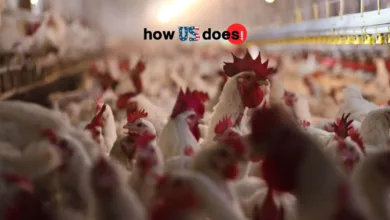How Does Bird Flu Infect Humans?

Unraveling the Enigma: How Does Bird Flu Infect Humans?

Introduction: Understanding the Complexities of Avian Influenza
Its a very common question that How Does Bird Flu Infect Humans? Bird flu, scientifically termed avian influenza, represents a formidable type A influenza virus that not only poses a significant threat to poultry populations but also harbors the potential for fatal consequences in humans. This highly contagious virus traverses between wild and domesticated bird populations, perpetuating its spread across geographical boundaries. Instances of transmission from birds to humans, particularly through close contact with infected poultry or birds, underscore the zoonotic nature of this viral infection.
Table of Contents for How Does Bird Flu Infect Humans..
While the direct human-to-human transmission of the bird flu virus remains uncommon, sporadic cases have been documented, typically involving individuals in close proximity to infected family members. However, the looming concern among scientists is the possibility of viral re-assortment, wherein the avian influenza virus may merge with a human flu virus, giving rise to novel strains with enhanced transmissible among humans.
Of particular concern is the H5N1 strain of bird flu, prevalent in Asian regions, which has inflicted considerable devastation since its emergence in 2003. With a staggering toll of over 130 fatalities across multiple countries, including Indonesia, Vietnam, Cambodia, Thailand, Turkey, Azerbaijan, Egypt, China, and Iraq, the H5N1 strain epitomizes the virulence of avian influenza and its profound impact on public health.
Australia, despite its stringent biosecurity measures, has not been immune to the threat posed by bird flu. Several outbreaks among commercial bird flocks have occurred, necessitating swift containment and eradication efforts to mitigate the spread of the virus within the country.
Understanding the intricate dynamics of avian influenza is paramount for devising effective preventive strategies and bolstering global preparedness against this persistent viral threat.
Understanding the Spread of Avian Influenza Virus
Understanding How Does Bird Flu Infect Humans, we should know that Avian influenza, often harbored by water birds like wild ducks, constitutes a pervasive threat owing to its ability to infect various avian species and potentially spill over into human populations. These water birds serve as the primary reservoirs for all avian influenza type A viruses, carrying the pathogens within their intestines and disseminating them into the environment through bird feces.
Notably, migratory birds carrying the virus during their extensive journeys pose a significant risk of spreading bird flu to countries they traverse. Despite being carriers, wild birds typically remain asymptomatic carriers of the virus, with exceptions noted in cases involving the H5N1 strain, which has manifested illness and fatalities among certain wild bird populations.
In contrast, domesticated birds, including chickens and turkeys, are more susceptible to the virulent effects of the avian influenza virus, often succumbing to severe symptoms such as diarrhea, respiratory distress, and even death. Afflicted birds shed the virus through various bodily secretions, including feathers, mucus, saliva, and feces, thereby amplifying the risk of transmission to humans.
Human infection with bird flu primarily occurs through close contact with sick birds, wherein individuals inadvertently come into contact with contaminated surfaces or materials. For instance, handling sick birds or poultry and subsequently neglecting proper hand hygiene can facilitate viral transmission, as the virus persists in bird feces and can be ingested through inadvertent hand-to-mouth contact.
Moreover, the consumption of raw poultry meat poses a potential route of transmission, although thorough cooking effectively eliminates the virus. Despite these transmission pathways, there is currently no substantiated evidence suggesting easy human-to-human spread of the circulating H5N1 strain of bird flu.
Understanding the intricate mechanisms of avian influenza transmission is crucial for implementing targeted prevention measures and minimizing the risk of human infections, underscoring the importance of stringent biosecurity protocols and public health interventions.
Recognizing the Symptoms of Bird Flu in Humans
While human infections of bird flu remain relatively rare, understanding the clinical manifestations and symptomatology is paramount for timely diagnosis and appropriate management. Although the precise incubation period of bird flu in humans remains elusive due to the scarcity of cases, it is typically estimated to range from three to 10 days post-exposure.
Further in order to under How Does Bird Flu Infect Humans, we should also know that the symptoms of bird flu in humans closely resemble those of conventional influenza, presenting with a constellation of manifestations that may include:
1. Fever:
Elevated body temperature is a hallmark feature of bird flu infection, indicative of the body’s immune response to viral invasion.
2. Sore Throat:
Irritation or discomfort in the throat often accompanies bird flu infection, contributing to the overall malaise experienced by affected individuals.
3. Cough:
A persistent cough is a common symptom observed in bird flu cases, characterized by both dry and productive coughing episodes.
4. Headache:
Headaches are frequently reported among individuals afflicted with bird flu, reflecting the systemic inflammatory response triggered by the viral infection.
5. Aching Muscles:
Myalgia, or muscle aches and pains, is a prevalent symptom associated with bird flu, contributing to the overall discomfort experienced by patients.
These clinical features, while nonspecific, collectively contribute to the diagnostic profile of bird flu in humans, prompting healthcare providers to consider the possibility of avian influenza in individuals presenting with influenza-like illness, particularly in regions where outbreaks are prevalent. Early recognition of symptoms is crucial for initiating prompt medical intervention and implementing appropriate infection control measures to mitigate the spread of the virus within the community.

Understanding the Potential Complications of Human Bird Flu Infection
While bird flu in humans may initially present with symptoms reminiscent of conventional influenza, it harbors the potential to precipitate a spectrum of severe and life-threatening complications. These complications, though relatively rare, underscore the gravity of avian influenza infection and necessitate vigilant monitoring and prompt medical intervention to mitigate adverse outcomes. Asking the question, “How Does Bird Flu Infect Humans”, some of the notable complications associated with human bird flu infection include:
1. Eye Infections:
Ocular manifestations represent a recognized complication of bird flu infection in humans, encompassing a spectrum of conditions ranging from conjunctivitis to more severe forms of eye pathology. Infection-mediated inflammation and tissue damage may culminate in ocular discomfort, visual disturbances, and compromised ocular health.
2. Pneumonia:
Bird flu infection can precipitate the development of pneumonia, characterized by inflammation and consolidation of lung tissue. Viral pneumonia, in particular, may ensue as a consequence of avian influenza virus replication within the respiratory tract, leading to impaired gas exchange, respiratory compromise, and systemic sequelae.
3. Acute Respiratory Distress Syndrome (ARDS):
Severe cases of bird flu infection may progress to acute respiratory distress syndrome, a life-threatening condition marked by widespread inflammation and compromised pulmonary function. ARDS is characterized by severe hypoxemia, respiratory failure, and systemic manifestations of organ dysfunction, necessitating aggressive supportive care and mechanical ventilation.
4. Inflammation of the Brain and Heart:
Neurological and cardiac complications represent rare yet serious sequelae of bird flu infection, underscoring the systemic impact of the virus on vital organ systems. Inflammation of the brain (encephalitis) and heart (myocarditis) may ensue secondary to viral dissemination or immune-mediated mechanisms, culminating in neurological deficits, cardiac dysfunction, and potentially fatal outcomes.
These complications underscore the multifaceted nature of bird flu infection and underscore the imperative for vigilant surveillance, comprehensive clinical management, and public health interventions aimed at curbing the spread of avian influenza within human populations.
Seeking Medical Attention After Traveling to Bird Flu-Affected Regions
Moving ahead in How Does Bird Flu Infect Humans, should you experience flu-like symptoms subsequent to returning from a country grappling with a bird flu outbreak, it is imperative to promptly seek medical attention to facilitate timely diagnosis and appropriate management. Here are some crucial steps to follow:
1. Contact Your Healthcare Provider:
Reach out to your healthcare provider as soon as possible to schedule an appointment for evaluation and assessment of your symptoms. Prompt medical intervention is crucial to ascertain the underlying cause of your illness and initiate appropriate treatment.
2. Inform Clinic Staff About Your Travel History:
When scheduling your appointment or upon arrival at the healthcare facility, ensure that you provide comprehensive details regarding your recent travel history, particularly any visits to regions or countries affected by bird flu outbreaks. Be forthcoming about your itinerary, including visits to markets, farms, or other locations where birds were present during your travels.
3. Describe Your Symptoms:
During your consultation with the healthcare provider, describe your symptoms in detail, including the onset, duration, and severity of flu-like manifestations such as fever, cough, sore throat, and muscle aches. Providing accurate information enables healthcare professionals to formulate an appropriate diagnostic and management plan tailored to your specific clinical presentation.
4. Undergo Diagnostic Evaluation:
Your healthcare provider may conduct various diagnostic tests, including laboratory investigations and diagnostic imaging studies, to assess your respiratory status and ascertain the presence of any underlying infections, including bird flu. Timely diagnosis is pivotal in implementing appropriate therapeutic interventions and minimizing the risk of disease transmission to others.
5. Follow Treatment Recommendations:
Based on the results of diagnostic evaluations and clinical assessments, your healthcare provider will outline a personalized treatment plan aimed at alleviating your symptoms, managing complications, and facilitating recovery. Adhere diligently to the prescribed treatment regimen and follow any additional recommendations provided by your healthcare provider to optimize your health outcomes. Hope till now you would have got several answers to your answer, “How Does Bird Flu Infect Humans?”
By proactively seeking medical attention and collaborating closely with healthcare professionals, individuals with a history of travel to bird flu-affected regions can expedite diagnosis, receive timely treatment, and mitigate the potential risks associated with avian influenza infection. Prompt intervention is paramount in safeguarding individual health and preventing the spread of infectious diseases within communities.
Potential for Viral Mutation and Pandemic Concerns: How Does Bird Flu Infect Humans?
Influenza viruses harbored by animal species possess the capacity to undergo genetic mutations, facilitating their adaptation to new host species, including humans. This phenomenon raises significant concerns regarding the potential for zoonotic transmission and the emergence of novel viral strains capable of causing severe illness in human populations. Here’s a detailed exploration of the implications and preventive measures associated with viral mutation and pandemic risk:
1. Mutational Dynamics:
Influenza viruses originating from animal reservoirs, such as avian species, possess inherent genetic variability that enables them to undergo genetic re-assortment or mutation upon encountering susceptible host populations, including humans. The emergence of viral strains with the ability to infect and transmit efficiently among humans poses a significant public health threat due to the lack of per-existing immunity in human populations.
2. Increased Disease Severity:
Viral strains originating from animal sources may exhibit enhanced pathogenic and virulence in human hosts, as the human immune system may lack effective defenses against novel viral antigens. Consequently, infections with zoonotic influenza viruses can manifest as severe respiratory illnesses with potentially fatal outcomes, particularly among vulnerable populations, such as the elderly and individuals with underlying health conditions.
3. Pandemic Potential:
Health experts and epidemiologists remain vigilant regarding the pandemic potential of zoonotic influenza viruses, including the H5N1 avian influenza strain, which has sporadically infected humans in regions spanning Asia, the Middle East, Africa, and Europe. The prospect of viral re-assortment or genetic mutation leading to the emergence of a highly transmissible and pathogenic strain capable of sparking a global pandemic remains a significant concern.
4. Historical Precedents:
The devastating impact of past influenza pandemics, such as the Spanish flu of 1918–1919, serves as a stark reminder of the catastrophic consequences of unchecked viral transmission within human populations. The Spanish flu pandemic resulted in millions of deaths worldwide, underscoring the urgent need for robust surveillance, preparedness, and response strategies to mitigate the risk of future pandemics.
5. Mitigation Strategies:
Efforts to contain the spread of avian influenza viruses and mitigate pandemic risks entail multifaceted approaches, including:
– Prompt identification and culling of affected poultry flocks to prevent viral amplification and transmission.
– Intensified research endeavors aimed at developing rapid diagnostic tests, effective vaccines, and antiviral therapies targeting emerging viral strains.
– Implementation of stringent quarantine measures to limit the spread of infection and prevent cross-species transmission events.
By employing comprehensive surveillance systems, bolstering research and development initiatives, and fostering international collaboration, public health authorities strive to mitigate the threat posed by zoonotic influenza viruses and safeguard global health security against the specter of pandemic outbreaks. Vigilance, preparedness, and proactive interventions are indispensable in averting the catastrophic consequences of emerging infectious diseases in an interconnected world.
Preparedness and Response Measures Against Avian Influenza Outbreaks
Robust planning and coordinated efforts at both federal and state levels are pivotal in effectively managing and containing potential outbreaks of avian influenza, or bird flu. in How Does Bird Flu Infect Humans, here’s an in-depth exploration of the strategic frameworks and preventive measures aimed at mitigating the impact of avian influenza outbreaks:
1. Government Action Plans:
In Australia, federal and state governments collaborate closely to develop comprehensive response strategies in anticipation of avian influenza outbreaks. The Australian Action Plan for Pandemic Influenza, overseen by the federal government, serves as a foundational framework for orchestrating a coordinated national response to public health emergencies, including avian influenza outbreaks. Concurrently, individual states, such as Victoria, have devised their Pandemic Influenza Plans delineating specific protocols and procedures to be implemented by state agencies and healthcare services in the event of an outbreak.
2. Veterinary Emergency Preparedness:
Recognizing the critical role of animal health in preventing and controlling avian influenza outbreaks, the Australian Veterinary Emergency Plan outlines targeted measures aimed at effectively managing bird flu incidents among bird populations, particularly within poultry farming settings. This specialized plan emphasizes the importance of early detection, rapid response, and containment strategies to curtail the spread of avian influenza viruses among domesticated bird populations.
3. Risk Mitigation Strategies:
Proactive measures aimed at minimizing the risk of avian influenza transmission encompass various interventions, including stringent biosecurity protocols and surveillance measures. Segregation of wild birds from domesticated bird populations, coupled with stringent hygiene practices and sanitation measures, serves as a crucial preventive strategy to mitigate the risk of cross-species transmission and viral dissemination. Additionally, ensuring access to safe drinking water for domesticated bird populations is paramount in maintaining their health and bolstering their resilience against infectious diseases.
By fostering close collaboration between governmental agencies, healthcare authorities, veterinary services, and relevant stakeholders, Australia endeavors to enhance its capacity to detect, respond to, and mitigate the impact of avian influenza outbreaks. Through sustained vigilance, proactive planning, and targeted interventions, the nation strives to safeguard public health, protect agricultural livelihoods, and uphold biosecurity standards in the face of emerging infectious disease threats.
Treatment and Vaccination Strategies for Avian Influenza
Now in the article, How Does Bird Flu Infect Humans, efficient management and prevention of avian influenza, or bird flu, entail a multi-faceted approach encompassing antiviral treatment options and strategic vaccination initiatives is necessary. Here’s an in-depth exploration of the therapeutic interventions and vaccination strategies aimed at mitigating the impact of avian influenza outbreaks:
1. Antiviral Medications:
A repertoire of antiviral medications utilized in the treatment of human influenza has demonstrated efficacy against avian influenza strains. These medications serve as pivotal treatment modalities for individuals exhibiting symptoms subsequent to potential exposure to avian influenza or as prophylactic measures for individuals in close contact with affected individuals. While current guidelines do not mandate the routine use of antiviral medications for individuals residing in Australia or those undertaking brief visits to affected regions, Australians residing in countries grappling with avian influenza outbreaks are advised to consider securing access to antiviral medications, subject to medical advice.
2. Government Stockpiling Initiatives:
As part of proactive preparedness measures and understanding How Does Bird Flu Infect Humans, the Australian Government has undertaken strategic stockpiling of essential antiviral medications, notably Relenza and Tamiflu, deemed efficacious in the treatment of human cases of bird flu. In the event of a human outbreak, these stockpiles serve as critical resources to sustain essential services, curtail viral transmission, and facilitate prompt treatment of affected individuals.
3. Vaccine Development:
While efforts are underway to develop a dedicated vaccine targeting avian influenza strains, such a vaccine is currently under development and not yet commercially available. It’s imperative to note that existing influenza vaccines do not confer protection against avian influenza viruses. However, individuals potentially exposed to avian influenza are encouraged to consider vaccination against human influenza viruses as a preventive measure, thereby reducing the likelihood of viral reassortment and the emergence of novel influenza strains.
By proactively harnessing antiviral treatment options, bolstering vaccine research and development endeavors, and fostering public awareness and preparedness initiatives, Australia endeavors to fortify its resilience against the threat of avian influenza outbreaks. Through collaborative efforts between governmental agencies, healthcare authorities, and research institutions, the nation remains steadfast in its commitment to safeguarding public health and fostering resilience against emerging infectious disease threats.
Travel Advice and Precautionary Measures for Avian Influenza
Now that we have understood, How Does Bird Flu Infect Humans, lets have a look at travel advisory by government. For individuals embarking on short visits to countries grappling with avian influenza outbreaks, the routine use of antiviral medications is not warranted. However, Australians residing in regions affected by bird flu are advised to prudently consider securing access to antiviral medications for potential use under medical supervision. This proactive approach includes maintaining a personal supply of antiviral medications, particularly for individuals residing in remote areas with limited access to healthcare facilities.
Here are some essential travel tips and precautionary measures to minimize the risk of avian influenza transmission:
1. Avoid Close Contact with Birds:
Steer clear of wild or domesticated birds, and refrain from visiting farms or marketplaces where birds are present. Minimizing direct contact with birds reduces the likelihood of exposure to the avian influenza virus.
2. Ensure Hygienic Practices:
Exercise caution, particularly with young children, to prevent inadvertent ingestion of contaminated objects or fingers. Thoroughly wash eggs before use, as eggshells may harbor bird feces. Additionally, practice stringent hand hygiene, washing hands thoroughly after handling eggs or raw poultry.
3. Cautious Food Handling:
Exercise vigilance when handling food products potentially contaminated with avian influenza virus. Avoid consuming foods containing uncooked eggs, such as mayonnaise, and employ rigorous food safety practices, including thorough cleaning of chopping boards and utensils post-handling of raw poultry.
4. Optimal Cooking Procedures:
Cook poultry products at high temperatures to ensure effective viral inactivation. Temperatures exceeding 80°C are capable of neutralizing the bird flu virus within approximately 60 seconds, thereby mitigating the risk of viral transmission through contaminated food sources.
By adhering to these proactive travel recommendations and embracing prudent hygiene practices, individuals can mitigate the risk of avian influenza transmission and safeguard their health while traveling to or residing in regions affected by bird flu outbreaks. Through collective vigilance and adherence to established preventive measures, travelers can navigate potential health hazards associated with avian influenza with confidence and resilience.
Where to Seek Assistance and Further Information
For individuals seeking guidance or requiring additional information regarding avian influenza, several resources and avenues of assistance are available:
– Your General Practitioner (GP/Doctor):
Your primary healthcare provider can offer personalized advice and medical assistance tailored to your specific needs.
– Emergency Animal Diseases, Agriculture Victoria:
For inquiries related to avian influenza among bird populations and agricultural concerns, you can contact Emergency Animal Diseases through Agriculture Victoria by dialing 136 186.
– Infectious Diseases Section, Department of Health, Victorian Government:
For information on public health measures, disease prevention, and other related matters, you can reach out to the Infectious Diseases Section of the Department of Health, Victorian Government, at 1300 651 160.
Hope we have covered every thing in the article, How Does Bird Flu Infect Humans. Do leave your valuable feedback in comments section below.
Read More:




